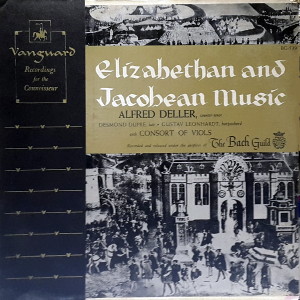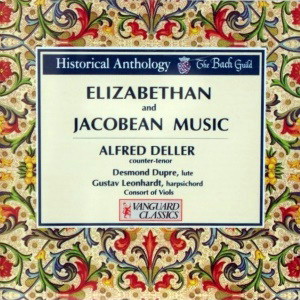 |
|
1 LP -
BG-539 - (p) 1954
|
 |
| 1 CD -
08 2027 71 - (c) 1994 |
|
| ELIZABETHAN
AND JACOBEAN MUSIC |
|
|
|
|
|
|
|
|
| John DOWLAND (1563-1626) |
"Can
she Excuse My Wrongs?" - Air |
counter-tenor
& ensemble
|
|
4' 12" |
A1 |
Thomas MORLEY
(1557-1602)
|
Air,
for Three Viols |
consort of viols
|
|
1' 28" |
A2
|
| John BARTLETT
(1565-1620) |
"Of
All the Birds that I Do Know"
- Air |
counter-tenor
& ensemble |
|
1' 58" |
A3
|
| Robert JOHNSON
(1569-1633) |
Alman,
for harpsichord, set by Giles
Farnaby |
harpsichord |
|
1' 13" |
A4 |
| John DOWLAND |
"If My
Complaints Could Passions
Move" - Air |
counter-tenor
& ensemble |
|
4' 20" |
A5
|
| John JENKINS (1592-1678) |
Pavan,
for four viols |
consort of viols |
|
5' 55" |
A6 |
Thomas CAMPIAN
(1567-1620)
|
"I
Care Not For These Ladies" - Air |
counter-tenor
& ensemble |
|
1' 38"
|
B1
|
| John DOWLAND |
"My
Lady Hunsdon's Puffe" - Air
for lute solo |
lute |
|
0' 59" |
B2
|
Robert PARSONS
(death 1570)
|
"Pandolpho"
- Air |
counter-tenor
& ensemble |
|
7' 20" |
B3 |
| John JENKINS |
Fantasia
in C for four viols |
consort of viols |
|
4' 55" |
B4 |
| John DOWLAND |
"From
Silent Night" - Air |
counter-tenor
& ensemble |
|
6' 15" |
B5 |
| Giles FARNABY
(1560-1640) |
Variations
for harpsichord on "Up Tails All" |
harpsichord |
|
6' 02" |
B6 |
|
|
|
|
|
|
| Alfred
Deller, counter-tenor |
Consort
of Viols
|
|
| Desmond Dupré,
lute |
- Eduard Melkus, treble
viol |
|
| Gustav Leonhardt,
harpsichord |
- Alice Hoffelner,
treble viol |
|
|
- Nicholas
Harnoncourt, bass viol |
|
|
- Gustav Leonhardt,
bass viol |
|
|
|
|
|
Luogo
e data di registrazione |
|
Vienna (Austria) -
maggio 1954 |
|
|
Registrazione: live
/ studio |
|
studio |
|
|
Produced by |
|
Seymour Solomon
|
|
|
Engineer
|
|
Franz Plott
|
|
|
Prima Edizione LP |
|
Vanguard - The Bach
Guild | BG-539 | 1 LP - durata 48'
06" | (p) 1954
|
|
|
Edizione CD |
|
Vanguard Classics |
08 2027 71 | 1 CD - durata 48' 06"
| (c) 1994 | ADD
|
|
|
Cover Art
|
|
- |
|
|
Note |
|
-
|
|
|
|
|
The
Elizabethan and Jacobean Age
in England was a period of the
most intimate relationship
between poetry and music.
Verse was conceived to be sung
and the two arts were never
more closely united and
interdependent. Whereas in the
madrigal, it was often
necessary for the composer to
compromise because of the
polyphony, in the less
involved accompanied solo song
a real bond between word and
tone was achieved. Both these
vocal forms enjoyed a brief
but rich flowering from the
last years of the sixteenth
century to about 1630.
Frequent literary references
to the airs would seem to
indicate that they were more
widely known than the
madrigals. Furthermore, the
practise of substituting
instruments for voices in the
madrigals ("apt for voyces or
violls") tended to make the
performers more interested in
the interplay of the parts
than in the poetry - a
situation wich provided an
incentive for the creation of
an indipendent instrumental
art. A sizeable body of
chamber music thus came into
being, in the form of
fantasias, In Nomines,
and dance pieces for consorts
of viols or wind instruments,
the like of which was unknown
in continental Europe until a
century later. The Fantasia
and Pavan of John
Jenkins (1592-1678) are among
the finest examples by a
master of this type of
compositions. The scores are
from a manuscript in the
British Museum in London.
Thomas Morley's (1557-1603) Air
for three viols appears in the
author's celebrated treatise,
A Plaine and Easie
Introduction to Praticall
Musicke, where it is an
illustration of a kind of
"song without words".
John Dowland's Book of Airs,
1597, was the first of a
series of "Airs to the Lute or
Viol" published by lutenist
composers, most of whom
performed and popularized
their songs before committing
them to print. Entitled, The
First Booke of Songes or
Ayres of fower parts with
Tablature for the Lute; So
made that all the parts
together, or either of them
severally may be sung to the
Lute, Orpherian or Viol de
gambo, the collection
was apparently a concession to
the contemporary fondness for
part-singing. Each song was
printed so that it could be
performed either by one person
who could sing the tune to his
own accompaniments, or by four
people who could sit around a
table and sing together from
one book. With few exceptions,
notably the above-mentioned
and Dowland's unique addition
of a treble viol obbligato for
three of his songs in The
Pilgrim's Solace, 1612,
the books of airs were printed
for voice and lute in
tablature notation. In the
third section of the song Can
she excuse my wrongs
Dowland uses a popular tune of
the day, The Woods so Wild
and If my complaints
was also know in many
instrumental settings as Captain
Piper's Galliard. These
are from The First Booke
of Songes or Ayres. From
silent Night, for voice,
lute, treble and bass viols,
is from A Pilgrim's Solace.
Besides his accomplishments as
one of the greatest
Elizabethan song writers, a
distinction he shares with the
poet-composer Thomas Campian
(1567-1620), Dowland
(1562-1626) was the
outstanding lute virtuoso of
his day. His music for the
instrument as well as the
numerous other surviving
contemporary manuscripts give
ample evidence of the highly
developed state of this solo
literature, the extent and
importance of which is only
now being investigated. The
lute solo, My Lady
Hundson's Puffe, exists
in manuscript in the British
Museum. Lady Hundson was
probably the wife of Sir
George Carey, the second Baron
Hudson to whom Dowland
dedicated his First Book
of Songes and Ayres.
Campian's air, I care not
for these ladies, set to
his own words, is one of the
best of the humorous songs of
the time. It is found in Part
One of Rosseter's Book of
Ayres, 1601.
Of all the birds that I do
know by John Bartlett
(fl. 1606) is from A Booke
of Ayres... 1606. Set to
a poem by George Gascoigne, it
is a skit on the name of his
friend Philip Sparrow, the
poet. The theme is, feed the
sparrow (any small bird in
Elizabethan times) and it will
do anything to please you. Pandolpho
by Robert Parsons (d. 1570) is
a song from a stage play, and
exists in manuscript in Kings
College, Cambridge.
Equally impressive in quality
and quantity is the remarkable
output of Elizabethan and
Jacobean keyboard music which,
after almost a century of
development, was thoroughly
sophisticated and completely
idiomatic in style and
technique. Giles Farnaby
(c.1560-c.1600), a name
perhaps less familiar than
those of Byrd, Bull and
Gibbons, was one of the most
original and imaginative of
the virginalists. ("Virginals"
was the English term for the
harpsichord in all its shapes
and sizes) Like all the
writers of this school he
utilized simple popular airs
or borrowed dance tunes as
themes for variations, the
form such keyboard music
usually assumed. Up Tails
All is based on a
popular country dance tune,
and is one of the most
elaborately worked out sets of
variations in the literature.
It appears in the Fitzwilliam
Virginal Book, which is
also the source for Farnaby's
harpsichord setting of the Alman
by Robert Johnson (1569-1633).
Notes
by Sydney Beck,
Music Division, New York,
Public Library
Alfred Deller is one of the
few contemporary masters of
the counter-tenor (pr male
alto) voice, for which Bach
and Purcell wrote some of
their most beatiful music. He
is also one of the great
interpretive musicuans of
modern times. Born at Margate,
Kent, in 1912, he made a
reputation as a boy soprano
and then moved easily into the
alto register. A favorite at
British music festivals, he
has also had a great success
on the continent, specializing
in the works of Dowland,
Purcell, Handel and Bach. Of
his art the Manchester
Guardian wrote, "His
production of this unusual
voice, and his technique, are
almost flawless, and his
phrasing is unsurpassed for
imagination and sensibility."
The Birmingham Post
wrote: "Mr. Deller , whose
wondrous voice graced both
Purcell and Danyel, is one of
the supreme British singers of
our generation."
Desmond Dupré, who plays the
lute on this recording,
studied cello at the Royal
College of Music. An
increasing interest in
pre-classical music led him to
take up the lute, guitar,
viols and cithern. The critic
Dyneley Hussey wrote of him,
"the versatile Desmond Dupré
seems to be master of any
bowed or plucked instrument."
He has accompanied Alfred
Deller in many notable
recitals.
Gustav Leonhardt is the
renowned Dutch harpsichordist,
organist, Baroque scholar, who
now teaches at the Vienna
Academy. The Leonhardt Baroque
Ensemble which he directs is
made up of outstanding
Viennese musicians dedicated
to the study of Renaissance
and Baroque music. In the
Consort of viol from this
ensemble, Leonhardt himself
plays bass viol, as does
Nicholas Harnoncourt. The
treble viols are Eduard Melkus
and Alice Hoffelner.
|
  |
|
|